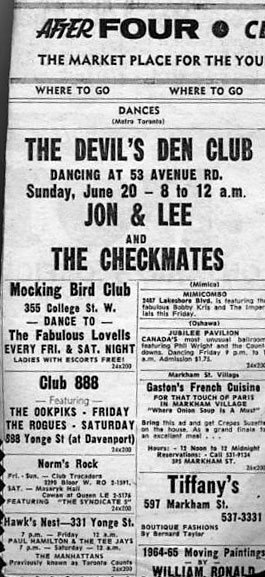
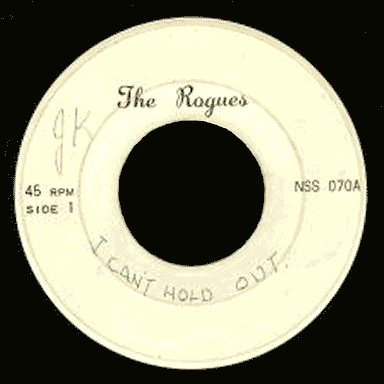 Together with Jon and Lee & The Checkmates, Mandala spearheaded a vibrant R&B scene in Toronto during the mid-1960s. Helmed by the late Domenic Troiano, the band recorded a string of stunning singles and a noteworthy album before morphing in to the funk blues group, Bush in late 1969.
Together with Jon and Lee & The Checkmates, Mandala spearheaded a vibrant R&B scene in Toronto during the mid-1960s. Helmed by the late Domenic Troiano, the band recorded a string of stunning singles and a noteworthy album before morphing in to the funk blues group, Bush in late 1969.
Although Mandala’s jazz-inspired soul-rock was too experimental for the mainstream rock market, interest in the band’s recorded output has been rekindled in recent years and a comprehensive CD detailing its entire work is long overdue.
Originally known as The Rogues, the group first came to prominence during the summer of 1964, working as the house band at the club Bluenote, supporting visiting US soul artists like The Supremes. Keyboard player Josef Chirowski (b. 2 March 1947, Germany), bass player Don Elliott (b. 8 December 1944, Toronto, Canada) and drummer Whitey Glan (b. Finland) had previously worked together in Whitey & The Roulettes (alongside future Luke & The Apostles guitarist Mike McKenna) and The Belltones.
During early 1965, former Belltones and original Roulettes singer George Olliver (b. 25 January 1946, Toronto, Canada) and ex-Robbie Lane & The Disciples and Ronnie Hawkins guitarist Domenic Troiano (b. Michaele Antonio, 17 January 1946, Mondugno, Italy, naturalised Canadian in 1955, d. 25 May 2005) completed the “classic” Mandala line up.
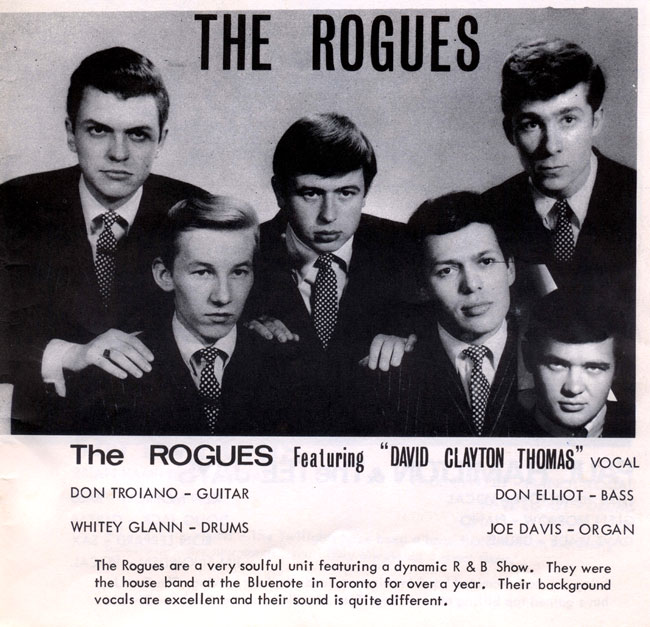
With Olliver and Troiano in place, The Rogues began playing extensively on the local scene, appearing regularly at clubs like the Devil’s Den, Club 888 and the Hawk’s Nest. For a brief period, the band took on a second lead singer – future Blood, Sweat & Tears front man David Clayton-Thomas but reverted to a five-piece in early 1966.
Following Clayton-Thomas’ departure, the band’s name was modified and, as The Five Rogues, they recorded two rare tracks – “I Can’t Hold Out No Longer” and “I’ll Make It Up To You” as rough demos.
The Rogues – I Can’t Hold Out Much Longer
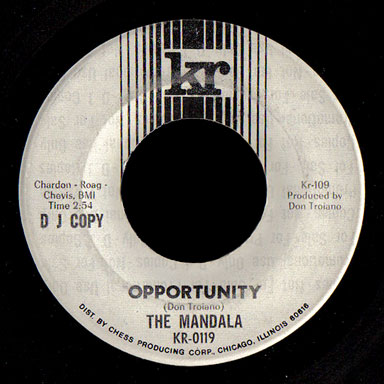 Throughout 1966, the group consolidated its local standing by landing some important support slots, most notably opening for Wilson Pickett at the Gogue Inn on 25 May, and The McCoys at the North Toronto Memorial Arena on 9 August. In September 1966, however, the band decided to reinvent itself and emerged with a new name and image – Mandala.
Throughout 1966, the group consolidated its local standing by landing some important support slots, most notably opening for Wilson Pickett at the Gogue Inn on 25 May, and The McCoys at the North Toronto Memorial Arena on 9 August. In September 1966, however, the band decided to reinvent itself and emerged with a new name and image – Mandala.
Mandala is a symbol (a circle within a circle within a circle) used by Buddhist monks as an aid to contemplation and was chosen by the band’s manager, Rafael Markowitz (aka Randy Martin), a former TV clown. Markowitz envisioned the band as being a channel for the audience to release its emotions and the newly named outfit returned to the Toronto scene with its “Soul Crusade”, which was met with mass hysteria.
In its new guise, Mandala also made a visual impact with their pinstripe, gangster-style suits and were apparently among the first Canadian bands to use strobe lights at their concerts. Markowitz proved to be a master at manipulating the media and made sure that the band was one of the best paid on the local circuit.
The US market soon beckoned and in late November, Mandala travelled to Los Angeles to play (initially) a weekend show at the Hullabaloo and four nights at the famous Whisky A Go Go in West Hollywood. Kicking off with a performance at the Hullabaloo on 26 November, Mandala’s stage show caused quite a stir and the following weekend a huge crowd turned up, curious to see what all the fuss was about.
In “Los Angeles ‘Sun-set’ raves over The Mandala”, an article for the Toronto Star published on 12 December, the Hullabaloo’s manager Gary Bockasta spoke about the band’s immediate impact on the scene. “They have built up an impetus since their first day,” he said. “They drew 1,000 people billed as co-headliners with a local group. The next Saturday night we had 1,400, which is a capacity crowd for us, and they were our only attraction.
“Almost all of this rush comes from word-of-mouth, since we do almost no paid advertising. I think you could say that, for the money we are paying them, they have been our most successful act so far.”
According to the newspaper report, the band had to cut its finale short at its final weekend show as teenyboppers thronged the stage clutching at Olliver and dragging Glan off his drum stool. What’s more The Monkees, who reportedly were interested in signing the band for a US tour with them, had to flee the club when the excited fans rushed the stage, fearing their own safety.
Thanks to their dynamic stage act, Mandala had won a recording deal with the KR label in the US and, on their return to Canada, recorded their debut single, Troiano’s “Opportunity” c/w Olliver’s “Lost Love” at Chess studios in Chicago with The Dells providing backing vocals. Released back home at the tail end of January 1967, the group’s debut single stormed into the Toronto top 10, peaking at #3 on the CHUM chart on 20 February.
“Opportunity” is arguably one of the best recordings to emerge from the Canadian rock scene during the 1960s. Propelled by Olliver’s soulful voice and The Dells’ massed vocals, the track’s infectious rhythm and Troiano’s gutsy guitar solo is totally absorbing. It’s just a shame that the single never broke into the US national charts or attracted a wider audience.
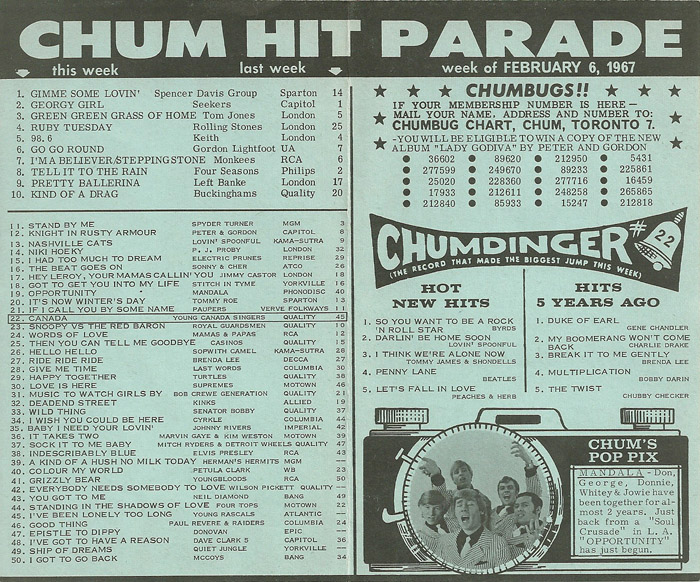
In March 1967, the band travelled to New York to perform at Steve Paul’s The Scene for an extended engagement, running from 6 March through to 2 April. While in the Big Apple, Mandala took part in Murray “the K’s” famous “Music in the Fifth Dimension” held at the RKO Theater from 25 March to 2 April. The show featured a number of artists, including Wilson Pickett and The Blues Project as well as British bands Cream and The Who, both making their debut US appearances. The group returned to Steve Paul’s The Scene for a second run from 25 April through to 4 May.
While all this was going on, the group’s second single, Victor Chambers’s “Give and Take” c/w band collaboration, “From Toronto ‘67” was released but didn’t fare as well as its predecessor, only peaking at #21 on Toronto’s CHUM chart on 22 May.
In mid-June, Mandala returned to the New York area to play two shows at the Farm at Monroe County Fairgrounds, followed by a welcome back tour, kicking off with a one-nighter at the Bonaventure in Montreal on 22 June. Then, shortly after a show at the Broom and Stone in Scarborough, Ontario with Livingstone’s Tripp on 9 July, Mandala headed back to New York to play at Steve Paul’s The Scene on 18 July. Later that month, the group participated in the highly publicised Garden of Stars show in Montreal.
Returning to Toronto the musicians began work on an album, but creative differences resulted in the sessions being abandoned and after another show at Steve Paul’s The Scene in New York on 27 September, Olliver quit the group in frustration. After a brief respite, where he spent three weeks in the north country wondering what to do next, he formed his own band, the 10-piece soul outfit, George Olliver & His (Soul) Children, which featured several musicians who would end up playing with Mandala in later years.
Speaking to Ralph Thomas in the Toronto Daily Star on 2 December, the day before his new group debuted at Marsaryk Hall in Toronto, Olliver confessed that one of the reasons why he left Mandala was because each member of the group had been on a mere $40-a-week salaries. “It’s true that our weekly salary was $40, but Randy [Martin, the group’s manger and part-owner] used to fine us $1-a-minute if we were late for rehearsals or appointments,” he says.
Olliver explained to Ralph Thomas that he found it hard to be on time in the first year because he was in a state of almost complete exhaustion from overwork. It particularly became a problem when Mandala played at the Murray the K Show from 10am to 10pm, followed by late evenings playing at Steve Paul’s The Scene, where the group worked from 11pm to 4am. “That left us about five hours of sleep a night,” he says. “If we got to the job late the next morning, there would be Randy with his little black book. I averaged about $20-a-week after fines.”
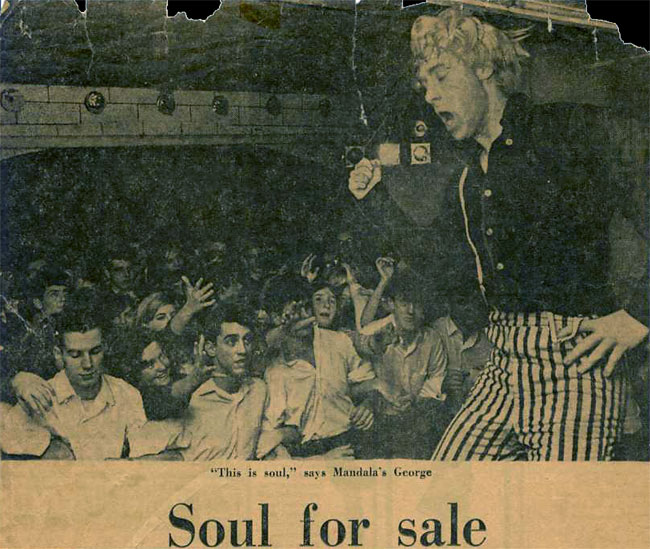
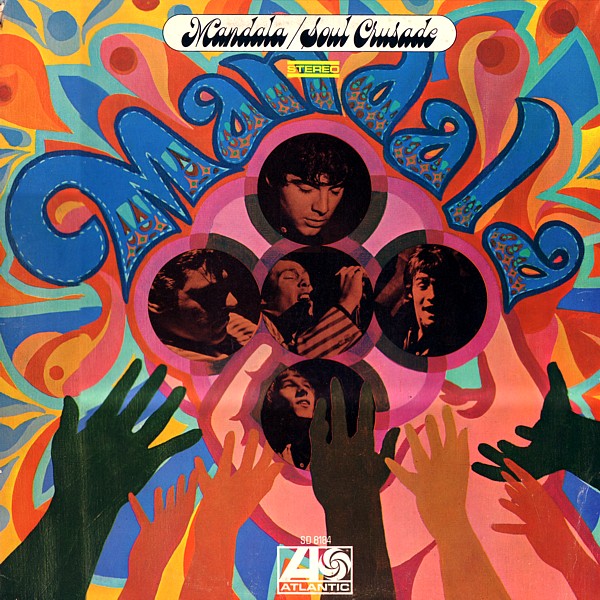

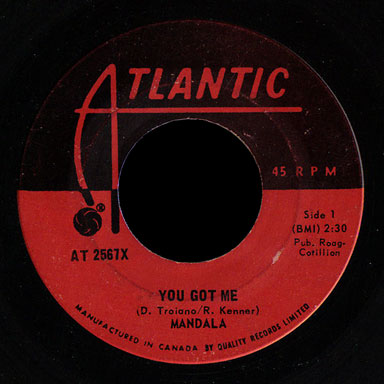 Despite gigging incessantly on the Toronto scene from December 1967-January 1969, and opening for The Hollies in Ottawa during March 1968, Olliver’s new group never recorded and in mid-1969, he emerged with a new outfit, Natural Gas, who recorded an album for Firebird Records in 1969 (the long player, incidentally, includes an Olliver-Chirowski instrumental from the Mandala repertoire, “Tribute to Rubber Boots”).
Despite gigging incessantly on the Toronto scene from December 1967-January 1969, and opening for The Hollies in Ottawa during March 1968, Olliver’s new group never recorded and in mid-1969, he emerged with a new outfit, Natural Gas, who recorded an album for Firebird Records in 1969 (the long player, incidentally, includes an Olliver-Chirowski instrumental from the Mandala repertoire, “Tribute to Rubber Boots”).
When the band broke up in late 1970 following a US tour, Olliver subsequently recorded two singles, “I May Never Get To See You Again” c/w “Shine” for Much Records and “Don’t Let The Green Grass Fool You” c/w “If I Can Just Be Strong Enough” for the Corner Stone label (with George Olliver and Friends) before playing and recording with Toronto band The Royals in the mid-’70s. He continues to perform regularly on the local circuit.
Olliver’s departure prompted keyboard player Chirowski to also leave in September 1967. At first Chirowski found work for Canadian Pacific Railways, but soon returned to the live scene with The Power Project. When that band folded, he became a member of the highly-rated rock band, Crowbar. During the ‘70s, Chirowksi worked with Alice Cooper and briefly toured with Lou Reed. In later years, he did session work for Peter Gabriel among others.
Mandala meanwhile recruited singer Roy Kenner (b. 14 January 1948, Toronto, Canada) and keyboard player Henry Babraj from local outfit Roy Kenner & The Associates, who’d made the obscure recording “Without My Sweet Baby”.The new line up debuted at the Roost in Ottawa on 8 October 1967 and the following month kicked off their fourth US tour with a show at the Cheetah in Hollywood.
While playing on the West Coast, Mandala supported Buffalo Springfield at the Swing Auditorium in San Bernardino, California on 3 November.The new personnel signaled a change in the group’s fortunes. After Atlantic chief Ahmet Ertegun acted on a tip from producer Phil Spector and bought the group’s contract from KR, Mandala returned to the studios to record their Soul Crusade album.
The band reportedly recorded six tracks at Atlantic Studios, New York in February 1968 with Arif Mardin, including the new single, the Scales/Jacobs written “Love Itis” c/w Troiano’s “Mellow Carmello Pallumbo”, which was another huge Toronto hit, peaking at #9 on the CHUM chart on 8 July 1968. The band completed the sessions for its long-awaited album, and while in New York, played a show at the Action House with The Fallen Angeles on 17 April.
After further shows on the West Coast, this time at the famed Troubadour in West Hollywood in May, Mandala returned to Toronto where keyboard player Barry Hutt was brought in to replace Babraj after an audition on Parliament Street. (Hutt, incidentally, later played in George Olliver and Friends.)
The new line-up continued to be a popular local draw but Barry Hutt did not stay long and was replaced by Hugh Sullivan from local group, Mr Paul and The Blues Council. Sullivan, who’d once been a member of George Olliver’s band, was later credited on the album’s sleeve for keyboards (along with Babraj). With Sullivan on board, the band made a prestigious appearance at the Philadelphia Music Festival on 24 July 1968.
Bad luck, however, dogged the band; Mandala had intended to tour Canada to promote Soul Crusade but Elliot was involved in a car accident and the tour was delayed until October.
Despite the setbacks, Soul Crusade received positive reviews in Canada. The album features some choice cuts, including “Every Single Day” co-written by Troiano with Kensington Market singer Keith McKie (when he was with The Vendettas) and Troiano’s “World of Love” and “Come on Home”. Local R&B singers Jimmy Livingstone, Diane Brooks, Eric Mercury and Shawn Jackson are among the cast of supporting players.
Mandala’s final single, the non-album tracks and Kenner-Troiano penned “You Got Me” backed by “Help Me”, was only given limited release in December and the group began to fall apart. Despite the positive reviews, the album failed to attract the sales the group had expected (some sources suggest that Ertegun felt artistic differences with Markowitz and Atlantic did not push the album).
During early 1969, the band made several visits to Michigan. On 7 April, Mandala played at the Detroit Pop Festival, held at the Olympia Stadium, alongside the MC5, SRC, Amboy Dukes and others, and then on the following day, performed at another festival, the Grand Rapids Pop Festival, held at the city’s Civic Auditorium, again with the same artists billed.
The end, however, was in sight. Returning to Ontario to play a string of dates, Mandala performed its final show on 1 June at the Hawk’s Nest in Toronto.
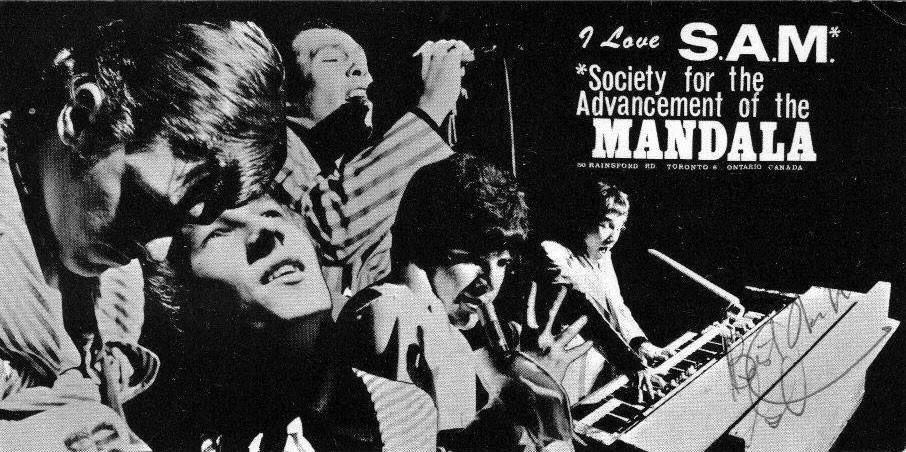
Following the group’s demise, Elliot went on to play with Leigh Ashford and Milestone while Sullivan moved to Los Angeles to briefly work with Toronto bass player/singer Neil Merryweather, before later doing sessions for former Steppenwolf frontman John Kay (alongside Glan).
Kenner, Troiano and Glan meanwhile brought in local bass player Prakash John and made a lone album as Bush (the live segment also features Sullivan) before splitting in 1971.
Glan and John subsequently became top session players, working for the likes of Lou Reed and Alice Cooper among others while Kenner and Troiano joined The James Gang after guitarist Joe Walsh left for a solo career. Troiano, who later joined The Guess Who and established a moderately successful solo career, sadly died in May 2005 after a long battle with cancer.
Kenner is currently doing jingles and voice-overs and working with a band in Toronto.While the group’s individual members have continued to plough successful careers as performers, Mandala’s recorded legacy remains largely undiscovered by the wider record buying public. The fact that the band’s Soul Crusade album and the non-album singles have yet to be picked up for a comprehensive CD collection probably doesn’t help, although there are murmurings that one collectors label may be set to put the record straight.
Many thanks to Carny Corbett, Bill Munson, Martin Melhuish, Nicholas Jennings, Brian Hunt, Elliott Prentice, Daniel Sneddon and Craig Webb for their help in piecing the Mandala story together. Special thanks to Craig Webb for the photos and transfers of Oppurtunity and the Rogues’ I Can’t Hold Out Much Longer. Hit Parader, Village Voice and Canadian Teen magazine also proved invaluable sources. Thank you to Ivan Amirault for the RPM scan.
To contact the author with further information or corrections, please email nick_warburton@hotmail.com
Copyright © Nick Warburton. All Rights Reserved. No part of this article may be reproduced or transmitted in any from or by any means, without prior permission from the author.
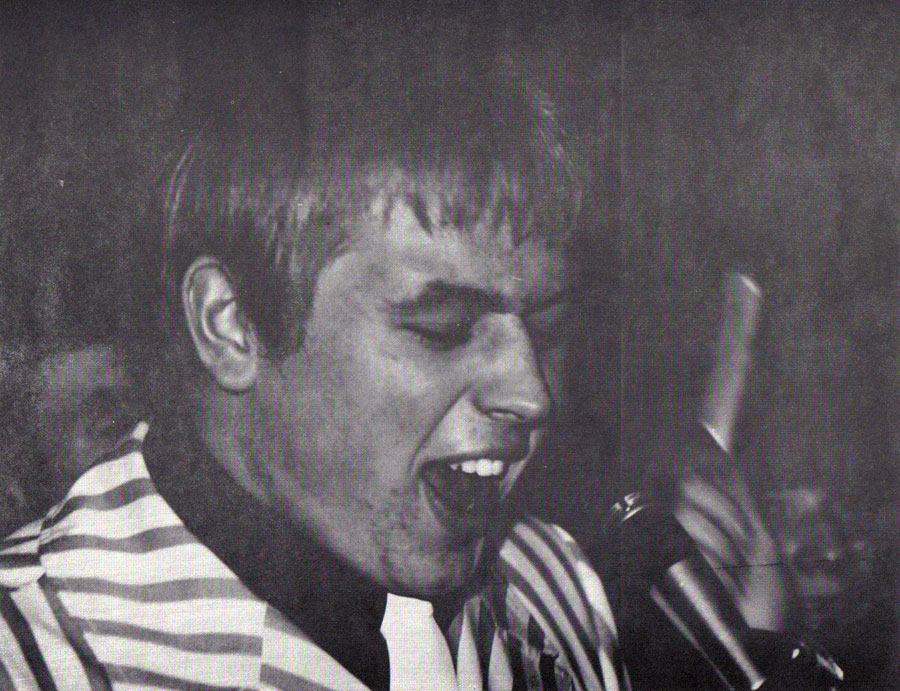
Mandala Promotional Bio (scans courtesy Ivan Amirault)
Page 1
Page 2
Page 3
Advertised gigs
October 9 1966 – Club Kingsway, Toronto with Shawne & Jay Jackson, The Majestics, The Secrets and The Tripp
November 26 1966 – Hullabaloo, West Hollywood
December 3 1966 – Hullabaloo, West Hollywood
December 1966 – Whisky A Go Go, West Hollywood with Fever Tree (four nights)
December 10 1966 – Hullabaloo, West Hollywood
December 16 1966 – Michael Power High School, Toronto
December 17 1966 – George Harvey High School, Toronto
December 26 1966 – The Hawk’s Nest, Toronto
December 29 1966 – Avenue Road Club, Toronto
January 7 1967 – The Hawk’s Nest, Toronto
January 12 1967 – Ryerson Winter Carnival, Ryerson Theatre, Toronto with Dee & The Yeomen, The Creeps and Dianne Brooks, Eric Mercury and The Soul Searchers
February 3 1967 – Hawk’s Nest, Toronto
February 11 1967 – Orange Hall, Brampton, Ontario
February 11 1967 – Clarke Hall, Port Credit, Ontario
February 12 1967 – Syndicate Club, Toronto (formerly Club Isabella) with The Syndicate Five
March 6-April 2 1967 – Steve Paul’s The Scene, New York with Eric Anderson
March 25-April 4 1967 – Murray the K’s Easter Rock Extravaganza, RKO Theater, Manhattan, New York with The Blues Project, Cream, Wilson Pickett, Jim & Jean, Chicago Loop, Mitch Ryder and others
April 8 1967 – YMHA, Toronto (first show back from US trip)
April 15 1967 – Oshawa Civic Auditorium, Oshawa, Ontario with The Tripp, Shawne Jackson, Jay Jackson & The Majestics, Jack Hardin & The Silhouettes, The Midnites and others
April 16 1967 – Crang Plaza, Downsview, Ontario
April 25-May 4 1967 – Steve Paul’s The Scene, New York
June 16-17 1967 – The Farm, Monroe County Fairgrounds, New York state
June 22 1967 – Bonaventure, Montreal (welcome back tour)
June 23 1967 – Kin-Oak Arena, Oakville, Ontario
June 24 1967 – Milton Arena, Milton, Ontario
June 27 1967 – The Hawk’s Nest, Toronto
June 30 1967 – North York Centennial Centre, Toronto with The Power Project, The Spirit and Livingstone’s Tripp
July 1 1967 – Orange Hall, Brampton, Ontario
July 9 1967 – Broom and Stone, Scarborough, Ontario with Livingstone’s Tripp
July 18 1967 – Steve Paul’s The Scene, New York
July 23-24 1967 – Le Hibou, Ottawa
July 30-August 5 1967 – Garden of Stars, Montreal
August 14 1967 – Laporte County Fair, Laporte, Indiana with The Detroit Wheels
August 14 1967 – Laporte County Fair, Laporte, Indiana with Every Mother’s Son
August 14 1967 – Laporte County Fair, Laporte, Indiana with Every Mother’s Son and The Grass Roots
September 27 1967 – Steve Paul’s The Scene, New York (probably George Olliver’s final show)
October 8 1967 – The Roost, Ottawa (probably Roy Kenner’s first show)
October 27-29 1967 – Cheetah, Hollywood, California (fourth US tour)
November 3 1967 – Swing Auditorium, San Bernardino, California with Buffalo Springfield and Yellow Payges
December 27-28 1967 – Mad Hatter, Allentown, Pennsylvania
April 17 1968 – Action House, New York with Fallen Angels
May 10-12 1968 – Troubadour, West Hollywood
June 27 1968 – North Toronto Memorial Arena, Toronto
June 30 1968 – Port Carling Surf Club, Port Carling
July 6 1968 – Balm Beach Danceland, Balm Beach, Ontario
July 13 1968 – Jubilee Auditorium, Oshawa, Ontario
July 20 1968 – Biquin Island Hotel, Bracebridge, Ontario
July 24 1968 – Philadelphia Music Festival, Philadelphia with The Who, The Troggs, Pink Floyd and others
August 3 1968 – Kee-to-Bala, Bala, Ontario with Rifkin
August 4 1968 – Pav-Orillia, Orillia, Ontario with Scarboro Fair
August 5 1968 – Nelson Arena, Burlington, Ontario with The Dana
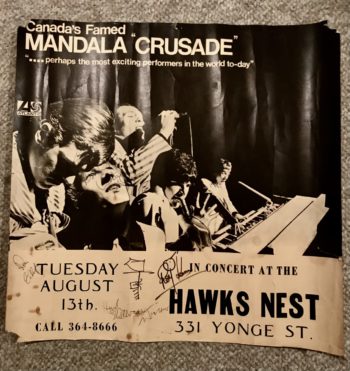
August 13 1968 – The Hawk’s Nest, Toronto
August 17 1968 – Balm Beach Danceland, Balm Beach, Ontario with Mornington Drive
August 24 1968 – Dorval Arena with the Raja
September 14 1968 – Broom and Stone, Scarborough, Ontario
September 21 1968 – Neil McNeil’s High School, Toronto
October 6-20 1968 – Canadian tour accident – Elliott drops out and others play as quartet with Sullivan covering bass on keyboards
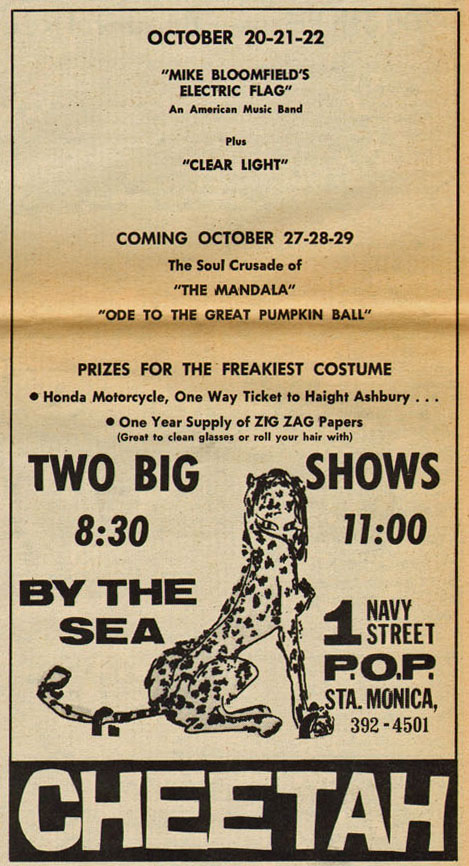

January 24 1969 – Village Pub, Detroit with Electric Blues Band
April 7 1969 – Detroit Pop Festival, Olympia Stadium, Detroit with MC5, SRC, Amboy Dukes and others
April 8 1969 – Grand Rapids Pop Festival, Civic Auditorium, Grand Rapids, Michigan with MC5, SRC, Amboy Dukes and others
May 17 1969 – Whitby Arena, Whitby with The Bedtime Story
May 24 1969 – Pavilion, Orillia, Ontario
June 1 1969 – Hawks Nest, Toronto
Sources: Ottawa Citizen, Montreal Star and “After Four” section in Toronto Telegram.
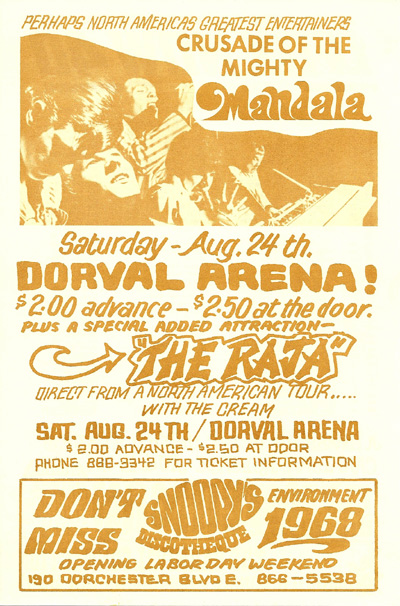


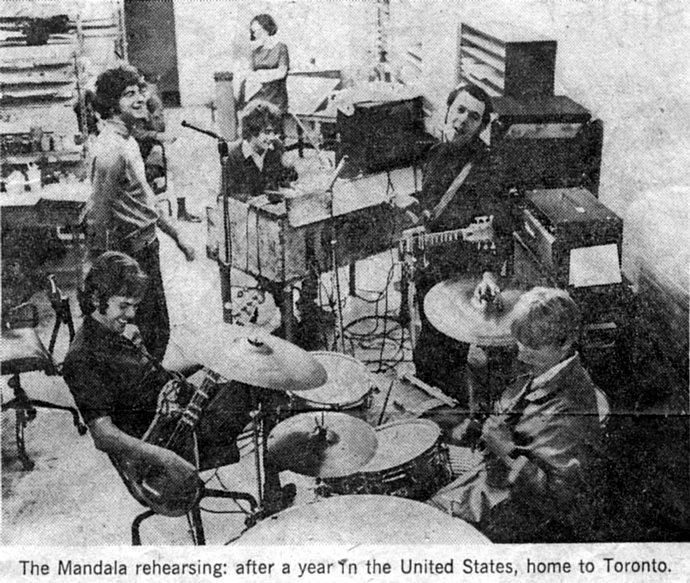
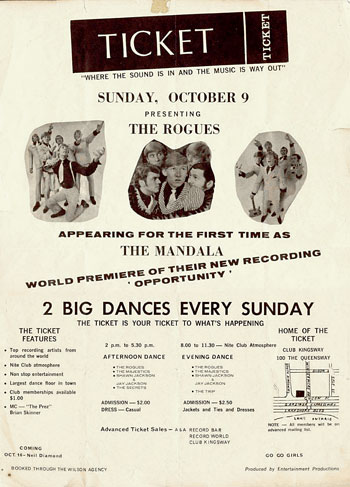
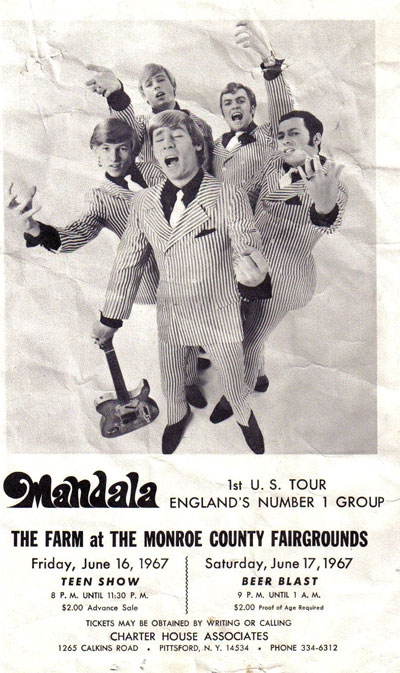
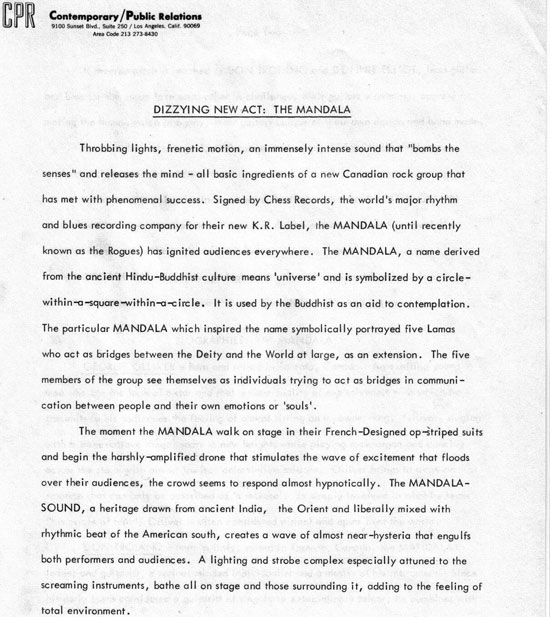
Nick, you are the best, man, but I have a small correction. I believe that the band at the Olympia was the SRC, who had a local hit with ‘Black Sheep’. Check it out here:
http://www.humvee.net/src/timeline.html
There is a good promotional film clip of Mandala demonstrating the ‘five steps of soul’ on Youtube.
Soul Crusade will finally be available on CD at the end of June 2010! Visit Pacemaker Entertainment’s website for info.
Nick…what a fabulous history! I roller skated to the “Five Rogues” nearly every Sunday at the Mimicombo. George was so cool with his “James Brown” act and remember Shawn and Jay Jackson as well. The pin striped suits with stove pants, man that was the best then.
Hi Nick:
Not a bad account Nick!
But you failed to mention my 1st solo group’s name. “George Olliver & His Children”. I was very proud of this 12 pc horn band. We toured New England in 1967-68 and our live performances were a huge hit. So much so that many people people in the Boston area remembered the band many years later.
Thanks again
George Olliver
In response to George Olliver’s email, this is my entry on the band, which is incomplete. The live dates are largely from the After 4 section in the Toronto Telegram:
GEORGE OLLIVER & HIS CHILDREN:
George Olliver (Vocals)
Hugh O’Sullivan (Keyboards)
Prakash John (Bass)
George Olliver formed this 10-piece band in November 1967 after leaving Toronto’s popular R&B band, Mandala. The group made its debut the following month. The band’s name altered slightly from ‘His Children’ to ‘His Soul Children’ throughout the year. In November 1968, he also started introduced his band as the George Olliver Show.
The group opened for The Hollies in Ottawa in March 1968. Some of the band’s members may have been involved with Olliver’s next project, Natural Gas. O’Sullivan had been in Mr Paul & The Blues Council and went on to Mandala while John went on to join The Stone Soul Children and Bush.
Advertised gigs
December 3 1967 – Masaryk Hall, Toronto (debut show)
December 8 1967 – Boogaloo Club, Hamilton, Ontario
December 16 1967 – St Basil, Toronto
December 26 1967 – The Hawk’s Nest, Toronto
December 29 1967 – Oshawa Civic Auditorium, Oshawa, Ontario, with Robbie Lane
December 31 1967 – Bunny Bin, Toronto with The Village Stop, Christopher Edward Campaign and The Revue of Stars
January 20 1968 – Broom and Stone, Scarborough, Ontario
February 9-11 1968 – Club Bluenote, Toronto (George Olliver joins Eric Mercury, Jay Jackson, Shawne Jackson and other singers on a bill with The Fabulous Peps)
February 16 1968 – Oakville Arena, Oakville, Ontario
March 2 1968 – The Hawk’s Nest, Toronto
March 20 1968 – Club Mimicombo, Mimico, Ontario
March 31 1968 – Teddy Bear Club, Toronto
April 6 1968 – Broom and Stone, Scarborough, Ontario with The Taxi (billed as George Olliver & His Soul Children)
May 10 1968 – Cedarbrae Collegiate, Scarborough (appears on Let’s Go TV on May 15)
May 31-June 2 1968 – Club Bluenote (Olliver joins Eric Mercury, Eddie Spencer, Shawne Jackson and Jay Jackson)
June 1 1968 – Club 888, Toronto
June 15 1968 – Silverthorn Collegiate, Toronto
June 25 1968 – Balmy Beach Club, Scarborough, Ontario
June 26 1968 – Club 42, Stratford, Ontario
June 29 1968 – Club Commadore, Kawarthas, Ontario
June 30 1968 – Broom and Stone, Scarborough, Ontario
August 27 1968 – Balmy Beach Club, Scarborough, Ontario
August 31 1968 – Balm Beach Danceland, Balm Beach, Ontario (billed as George Olliver & His Soul Children)
September 1 1968 – Summer Gardens, Port Dover, Ontario (billed as George Olliver & His Soul Children)
November 30 1968 – Broom and Stone, Scarborough, Ontario (billed as George Olliver Show)
December 13 1968 – Jubilee Auditorium, Oshawa, Ontario (billed as George Olliver & His Children)
December 14 1968 – The Hawk’s Nest, Toronto (billed as George Olliver Show)
January 3 1969 – Balmy Beach Club, Scarborough, Ontario (billed as George Olliver & His Children)
I saw Mandala preform at LaPorte county fair in LaPorte Indiana on August 14 1967.That was the best performance i have ever seen. I will never forget them. I bought a fender telecaster and i started learning to play the blues. I named my guitar Mandala. Don Troiano is my insperation. I will never forget the soul sounds he had on his tele. They were awhsome. Thanks Lee Lanning
nice account of Mandala one correction I see is stating that Chirowski toured briefly with Lou Reed that is not so when Reed went out solo with Hunter Wagner Glan John and Colcord Joey was busy with Crowbar from August 70 until Jan 74 I was there we were best friends March 74 he got the call from Ezrin to try out for the Alice Cooper solo band (Nightmare Band)and again I was there.
Thanks for the correction
Don Elliott died recently
Was Don married? A friend of mine used to date him in the late 60’s.
Sorry to hear that.Grew up around the corner in Willowdale.Great music times.rip Bob
Any details on his death? Also wondered if you had any on Hugh Sullivan. I heard he died in 1978.
Hi Doug;
I am a cousin of Hugh Sullivan. I have an entry in my 1977 day book on October 18 that I was informed that Hugh had committed suicide by hanging in Toronto a few days earlier. This would have been in the family home at 34 Fallingbrook Rd. He was discovered by his mother which of course gave her quite a shock. I attended his memorial service on October 20. Hugh came from a very musical family. His father was William Sullivan, a professional trumpeter who incidentally was on board the SS Noronic in the dance band when the Noronic caught fire in Toronto harbour on September 1949 with the loss of 118 lives. William had luck and survived this incident. He also played trumpet at the Woodbine horse race track in Toronto. Hugh’s mother was Virginia Sullivan (nee Trueman) who was head of the music department at Pickering High School for about 25 years. See https://www.legacy.com/obituaries/thestar/obituary.aspx?n=virginia-balloch-sullivan&pid=176186965&fhid=12317 for details. Music also ran in other branches of the Sullivan family. My father, Edward Sullivan, was a professional musician and music teacher for his entire career.
Thank you Vincent. I had heard rumours of Hughie’s sad death. Hughie was the drummer in my band when we were both about 14 years old in Scarborough called “The Toppers”. We recorded an album that was only distributed locally around RH King Collegiate, to neighbours, relatives and friends. Hughie didn’t continue at RH King, but went to Birchmount Collegiate when it was built. I lost track of him until I heard he had been with Jon Kay, George Olliver, then Mandala. We rehearsed sometimes at Hughie’s house (I thought it was on Kalmar, just up from Kingston Rd). Hughie was a really talented musician even back then!
Hi Gord;
Your memory is very good! At the time of the Mandala (and earlier) the William Sullivan family did indeed live on Kalmar Avenue and I remember it being mentioned during family visits that the Mandala rehearsed there.. Theirs was the first house on the left (West) side of Kalmar just North of Kingston Rd. I just took a quick look on Google maps and it appears the house is not there any more… It is now a parking lot. By 1977 the family had moved to the Fallingbrook Ave. address that I mentioned. I was unaware that Hugh was also a drummer. Thanks for that little bit of Sullivan family history!
I was in my mid teens when Mandala exploded and I was a huge fan. My friend and I saw them in concert at the High School of Commerce in Ottawa That would have been either 68 or 69 and I was so disappointed when the band broke up. They were so unique and powerful. Ottawa also had a very popular band MRQ who played frequently at public functions and I never missed an opportunity to see them. To say they were also amazing is a huge understatement. Mandala and the MRQ ( Modern Rock Quartet ) were the two finest bands in all of Canada. Its so sad that so little remains of the Mandala legacy, And virtually nothing at all remains of the fabulous MRQ. Whoever invents a time machine I’ll be your first passenger. These 2 late 60’s bands were the crown jewel of Canadian rock. There will never be anything like it.
I saw them at their Soul Crusade show at Oshawa Civic Auditorium on Apr 15,1967 They were the main attraction at a 2 day marathon event tha included The Tripp, Shawne and Jay and the Majestics,Jack Hardin and the Silhouettes, Diane Brooks,Eric Mercury and others who I have forgotten . Their performance was outstanding and the whole place was standing room only